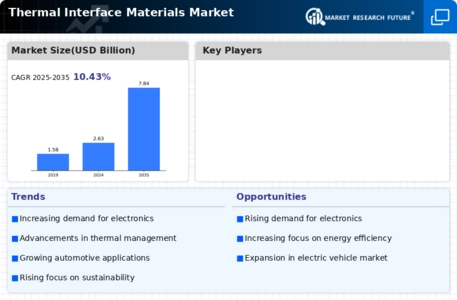Expansion of Consumer Electronics
The expansion of the consumer electronics sector serves as a crucial driver for the Thermal Interface Materials Market. With the proliferation of devices such as smartphones, tablets, and laptops, the demand for efficient thermal management solutions has surged. As devices become more compact and powerful, the heat generated during operation increases, necessitating the use of high-performance thermal interface materials. Market data indicates that the consumer electronics segment accounts for a substantial share of the thermal interface materials market, with projections estimating a growth rate of approximately 8% annually. This trend underscores the importance of thermal interface materials in maintaining device performance and longevity, as manufacturers strive to enhance user experience while managing thermal challenges effectively.
Growth in Renewable Energy Sector
The growth in the renewable energy sector is emerging as a significant driver for the Thermal Interface Materials Market. As the world shifts towards sustainable energy solutions, the demand for efficient thermal management in solar panels and wind turbines is increasing. Thermal interface materials play a vital role in ensuring optimal heat dissipation in these applications, thereby enhancing energy conversion efficiency. Market analysis suggests that the renewable energy segment is expected to witness a CAGR of around 9% over the next few years, driven by the rising investments in clean energy technologies. This growth presents opportunities for manufacturers of thermal interface materials to innovate and develop specialized products tailored for the unique thermal challenges posed by renewable energy systems.
Increasing Adoption of Electric Vehicles
The rising adoption of electric vehicles (EVs) is a pivotal driver for the Thermal Interface Materials Market. As the automotive sector transitions towards electrification, the demand for efficient thermal management solutions intensifies. EVs generate substantial heat during operation, necessitating effective thermal interface materials to ensure optimal performance and safety. The market for thermal interface materials in the automotive sector is projected to grow significantly, with estimates suggesting a compound annual growth rate (CAGR) of over 10% in the coming years. This growth is largely attributed to the need for enhanced thermal conductivity and reliability in EV battery systems, which are critical for extending vehicle range and lifespan. Consequently, manufacturers are increasingly investing in advanced thermal interface materials to meet these evolving requirements.
Technological Advancements in Electronics
Technological advancements in electronics are significantly influencing the Thermal Interface Materials Market. Innovations such as 5G technology and artificial intelligence are driving the development of high-performance electronic components that require effective thermal management. As devices become more sophisticated, the heat generated by processors and other components increases, necessitating the use of advanced thermal interface materials. Market data indicates that the demand for these materials in high-performance computing applications is expected to grow at a CAGR of approximately 7% in the coming years. This trend highlights the critical role of thermal interface materials in ensuring the reliability and efficiency of next-generation electronic devices, as manufacturers seek to push the boundaries of performance while managing thermal challenges.
Regulatory Standards for Thermal Management
Regulatory standards for thermal management are becoming increasingly stringent, acting as a driver for the Thermal Interface Materials Market. Governments and regulatory bodies are implementing guidelines to ensure safety and efficiency in various applications, particularly in the automotive and electronics sectors. These regulations often mandate the use of effective thermal management solutions to prevent overheating and ensure product reliability. As a result, manufacturers are compelled to adopt high-quality thermal interface materials that comply with these standards. Market Research Future suggest that adherence to regulatory requirements is likely to propel the demand for thermal interface materials, with an anticipated growth rate of around 6% in the next few years. This trend underscores the importance of regulatory compliance in shaping the market landscape and driving innovation in thermal management solutions.

















Leave a Comment